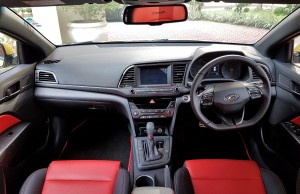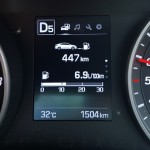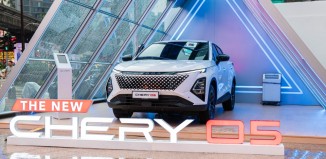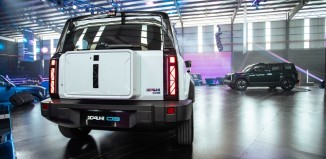Hyundai Elantra Sport – Turbo Powered Now!
Most major automakers are doing ‘downsizing’ exercises to their vehicles, i.e. put in a smaller capacity engine, but turbo-charge it to provide an equivalent amount of power, and Hyundai is following suit – you will find it in the latest edition of the Hyundai Elantra, which kind of ‘slipped in’ a few months ago.
 The Hyundai Elantra, with its 2,700mm wheelbase and overall length of 4,570mm, is a C-segment car – the wheelbase is the main criteria, and the current ‘magic’ number is 2,700mm. For the uninitiated, the wheelbase of a car refers to the centre-to-centre distance between the front and rear wheels of a vehicle – this more or less determines the amount of cabin space available. In terms of size, the Elantra compares with the likes of the Toyota Altis, Honda Civic and the Mazda3.
The Hyundai Elantra, with its 2,700mm wheelbase and overall length of 4,570mm, is a C-segment car – the wheelbase is the main criteria, and the current ‘magic’ number is 2,700mm. For the uninitiated, the wheelbase of a car refers to the centre-to-centre distance between the front and rear wheels of a vehicle – this more or less determines the amount of cabin space available. In terms of size, the Elantra compares with the likes of the Toyota Altis, Honda Civic and the Mazda3.
When you downsize to a smaller engine capacity, it helps to save fuel when you are idling, or coasting on ‘negative’ throttle due to the fact that the engine is smaller, and thus does not require as much fuel as a bigger capacity engine to keep it running. The turbocharger helps it to produce more power when you are accelerating – and here most automakers have to decide whether to give it more power than the original, or less. In the case of Hyundai, they decided to give it more power than the original – this is like killing two birds with one stone, i.e. downsizing but packing a bigger wallop.
 Thus we find that the 2.0 litre variant has less power and torque – 150 hp and 192Nm of torque, versus the 1.6 turbo variant with approximately 200 hp and 265Nm of torque. Personally, I find the 2.0 litre naturally aspirated engine quite redundant, but I suppose it is all right for Hyundai to maintain it in its stables as a backup to cater for those who still do not trust turbocharged engines. If it is any consolation, the 2.0 litre variant costs less than the 1.6 litre turbo.
Thus we find that the 2.0 litre variant has less power and torque – 150 hp and 192Nm of torque, versus the 1.6 turbo variant with approximately 200 hp and 265Nm of torque. Personally, I find the 2.0 litre naturally aspirated engine quite redundant, but I suppose it is all right for Hyundai to maintain it in its stables as a backup to cater for those who still do not trust turbocharged engines. If it is any consolation, the 2.0 litre variant costs less than the 1.6 litre turbo.
 However, one must remember that with a turbo raring to go, the driver and his driving style has a direct impact on the fuel consumption – the harder you drive, the higher the fuel consumption – in theory fitting on a turbo can help fuel consumption, but if you put pedal to the metal, true to the adage that you cannot get something for nothing, the price you pay for the extra grunt is for more fuel.
However, one must remember that with a turbo raring to go, the driver and his driving style has a direct impact on the fuel consumption – the harder you drive, the higher the fuel consumption – in theory fitting on a turbo can help fuel consumption, but if you put pedal to the metal, true to the adage that you cannot get something for nothing, the price you pay for the extra grunt is for more fuel.
The 2017 model is all-new, and sets a new standard in its segment with new levels of sophistication applied to its interior and exterior as well as a platform, which delivers a new level of ride comfort with smooth, precise handling and enhanced safety. Key highlights of the new upgraded model include:
- ‘Dynamic Precision’ – The New Fluidic 2.0 Design Concept
- New Powerful Powertrain – Nu 2.0 MPI and Gamma 1.6 T-GDI
- State-of- the-art platform with the use of 53% Advanced High-strength Steel (an increase of 32% as compared to the previous model), offering improvement in torsional stiffness, ultra-rigid chassis and bending resistance strength
- Comprehensive Safety Features include:
o Vehicle Stability Management (VSM)
o Electronic Stability Control (ESC)
o Hill-start Assist Control
o 6 Airbags
o Emergency Fastening Device
o Blind Spot Detection (Applicable for Elantra Sport only)
o Intelligent Technology and Convenient Features which include:
o Hands-free Smart Trunk
o AV System that supports Android Auto and Car Play
o Rear camera
o Auto Cruise Control
o Front and Rear Parking Assist
I have taken the Elantra Sport (with the 1.6 litre turbocharged engine for a test drive, and will be getting the 2.0 MPI variant soon, so for the moment, we shall talk only about the Elantra Sport. The turbo drivetrain is similar to that which is found in the Veloster, but instead on being restricted to a hatch design, having this drivetrain in a sedan opens up the borders for ‘family’ type persons who want the additional performance and still have a vehicle that can suit his or her day-to-day needs.
The car actually has a lot of grunt due to its 1.6 litre DOHC turbocharged direct injection engine. Made of aluminium to keep overall weight down, and also helps engine cooling, the Elantra Sport can do the zero to 100km per hour sprint in 7.5 seconds, and hit a top speed of 200 kph.
 Drive is to the front wheels through a 7-speed dual clutch transmission (DCT), with close ratio gears and a lowered final drive. The DCT also minimises clutch slip and cuts down shift times, besides which the drive feel is very direct, very different from a slush box, which is named thus for obvious reasons. Having said that, there are some slush boxes that are pretty good, especially the newer German-made ones.
Drive is to the front wheels through a 7-speed dual clutch transmission (DCT), with close ratio gears and a lowered final drive. The DCT also minimises clutch slip and cuts down shift times, besides which the drive feel is very direct, very different from a slush box, which is named thus for obvious reasons. Having said that, there are some slush boxes that are pretty good, especially the newer German-made ones.
I took the Elantra Sport down to Port Dickson through the winding roads that start from behind the Sepang International Circuit, through to Sepang and onto Lukut. On the road, the Elantra Sport is quite fun to drive, especially when you look at the surprised faces on other drives as you leave them behind at the traffic lights upon the green light. Overtaking is also a breeze, and the paddle shifters do help. A Sport mode button is available if you want a few more revs in each gear.
The 17-i nch wheels fitted with 225/45 R17’s specified for Malaysia work well enough – in some other countries, 18-inch is standard issue, and the handling will be better, but having said that, the cost of replacing 17’s is much lower than 18’s. The 17’s performed well enough, so there is no problem there. Anyway, 17-inch tyres are a whole lot cheaper to replace than 18’s.
nch wheels fitted with 225/45 R17’s specified for Malaysia work well enough – in some other countries, 18-inch is standard issue, and the handling will be better, but having said that, the cost of replacing 17’s is much lower than 18’s. The 17’s performed well enough, so there is no problem there. Anyway, 17-inch tyres are a whole lot cheaper to replace than 18’s.
The suspension of the Elantra Sport is constructed differently from its naturally aspirated siblings – the rear is a multi-link arrangement instead of a torsion bar, and the shock absorber and spring rates are also tweaked to give a firmer ride. Thus the Elantra Sport handles quite well, and if I were to give it a rating, I would say that it is on the ‘comfortable side of firm’. This kind of set-up would be great for a person who uses the Elantra Sport as a daily driver and needs a reasonable level of comfort, but every once in a while wants to drive fast. For the ‘serious enthusiast, I would recommend a ‘sports’ upgrade.
Fuel economy is pretty decent – I would say that the 11.7 kilometres per litre (equivalent to 8.54 litres per 100 km) I got from a mixed driving style would be typical for the average road user. A person with a light foot could probably get a little better result (like what my Autoworld compatriot, Zachary Ho, did), but if you want fuel economy, maybe you might want to go for the naturally-aspirated version. The Elantra Sport is meant for those who want more performance; with the turbo you have a choice, as driving with a light foot can actually yield good results, but you would have paid more for the higher tech in the first place – for me, I would go straight for the turbo.
So, after all this, would I pick the Elantra Sport? Well, if I had a budget that is close to its asking price of RM131,488.00, it would certainly be on my test drive list.
Zachary also had a go with the Elantra Sport and this is what he had to say:
The new Elantra has been given a more mature and continental look, pleasing to the eye but not necessarily outlandish; some people buy into outlandish so Fluidic 2.0 could be a “miss” in this market. Personally, I like the way it looks; I also like the HID headlamps with the subtle red decorative trim to denote its sporty intentions, and the front grille with less chrome than its non-turbo sibling (and with a tiny ‘Turbo’ badge).
 I also like the rear seat which has sufficient legroom, as well as good thigh support for tall adults. The rear center passenger also enjoys a relatively flat seat and flat floor, and rear cooling vents. Of course, with a 5th passenger, you don’t get to use the rear armrest nor the 2 cup holders within it. Up front, the sporty flat-bottomed steering wheel is nice to hold; and in 2017, there’s still a C-segment sedan that features a handbrake lever which means it’s still easy to do handbrake turns with the Elantra. The carbon fiber trim on the dashboard is quite low-key but helps to break up the monotony.
I also like the rear seat which has sufficient legroom, as well as good thigh support for tall adults. The rear center passenger also enjoys a relatively flat seat and flat floor, and rear cooling vents. Of course, with a 5th passenger, you don’t get to use the rear armrest nor the 2 cup holders within it. Up front, the sporty flat-bottomed steering wheel is nice to hold; and in 2017, there’s still a C-segment sedan that features a handbrake lever which means it’s still easy to do handbrake turns with the Elantra. The carbon fiber trim on the dashboard is quite low-key but helps to break up the monotony.
 Which brings me to what I don’t like. It is 2017 and the dashboard has retro looks not everyone can appreciate, although in its defense, all the switches are within easy reach and the touchscreen is recessed so it gets some shelter from our glaring sun. It also looks like Hyundai had tried to compensate for the muted dashboard with very prominent red accents on the seats and door cards. Frankly, I prefer just red trim or stitching that will still exude some sportiness but isn’t so in-your-face.
Which brings me to what I don’t like. It is 2017 and the dashboard has retro looks not everyone can appreciate, although in its defense, all the switches are within easy reach and the touchscreen is recessed so it gets some shelter from our glaring sun. It also looks like Hyundai had tried to compensate for the muted dashboard with very prominent red accents on the seats and door cards. Frankly, I prefer just red trim or stitching that will still exude some sportiness but isn’t so in-your-face.
Like YS said, this car can grunt. A lot. And in a fun way. On paper, it has more power and does the 0 – 100 km/h time faster than its nearest Asian turbocharged rival. And it also proves that on the tarmac. The handling is taut, thanks in part to an improved chassis, and the ride is a little firm (we get the Australian-grade suspension tune) which is to be expected for a car that can be driven in a very excited manner; go for the 2.0L if you want a softer ride.
 The dual clutch transmission is effective most of the time and I seldom needed the paddle shifters. And while the steering is precise, it lacks a direct feel which is typical of electric ones. But to prove a point that it can still be frugal despite all the power, I drove a stint in a mix of mild and smooth traffic and managed a best average of 6.7 liters per 100 km (the image shows it slightly higher as that was the only opportunity to have a picture taken). Better results could be possible as I’m not the lightest of foot. On the other hand, it’s also a waste to have this much power at your disposal and not make use of it.
The dual clutch transmission is effective most of the time and I seldom needed the paddle shifters. And while the steering is precise, it lacks a direct feel which is typical of electric ones. But to prove a point that it can still be frugal despite all the power, I drove a stint in a mix of mild and smooth traffic and managed a best average of 6.7 liters per 100 km (the image shows it slightly higher as that was the only opportunity to have a picture taken). Better results could be possible as I’m not the lightest of foot. On the other hand, it’s also a waste to have this much power at your disposal and not make use of it.
In summary, I enjoyed the car for all its worth. It’s not perfect but it has all the right boxes ticked on the equipment, features and driving fronts. But if I were to buy the Elantra Sport, I will invest in some seat covers. Unless you like the red.
Gallery:






























